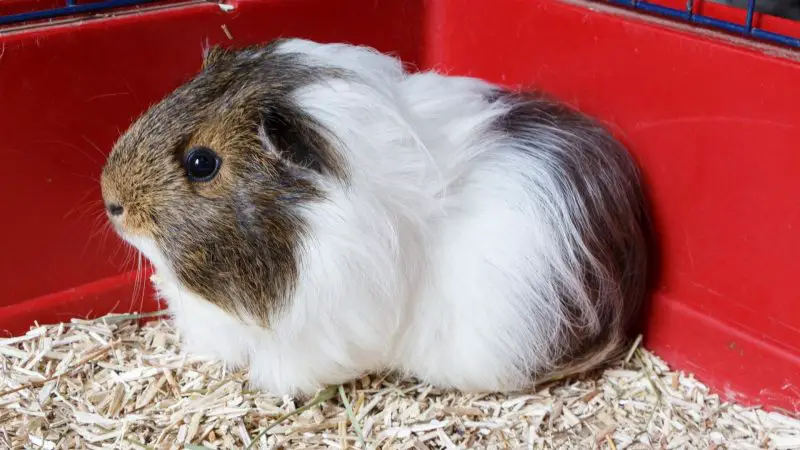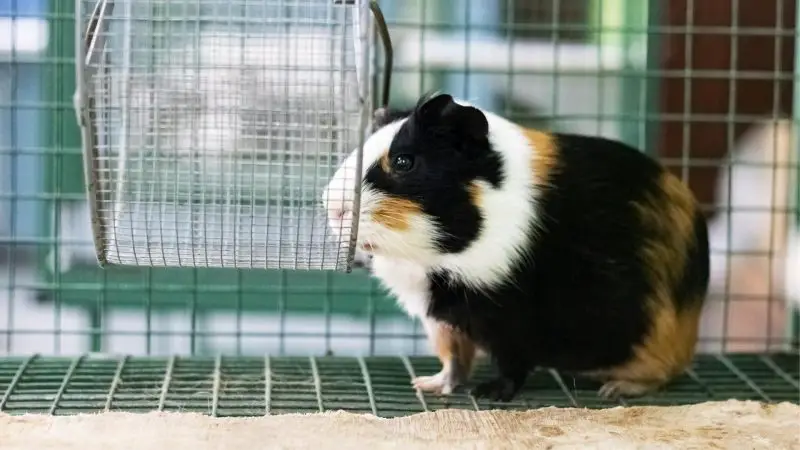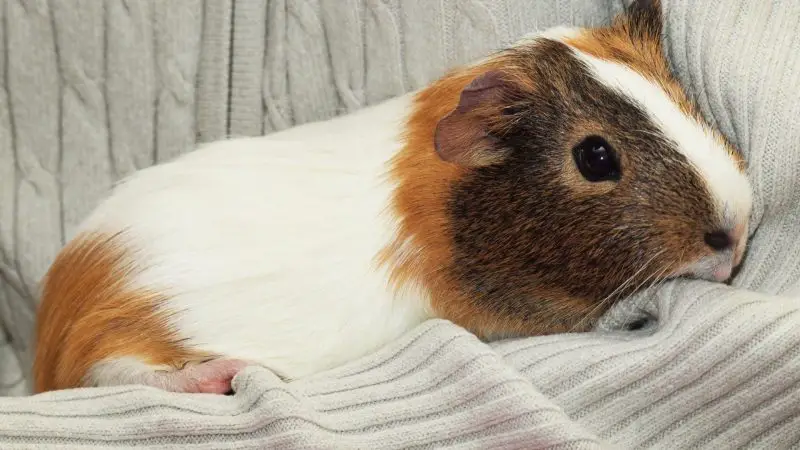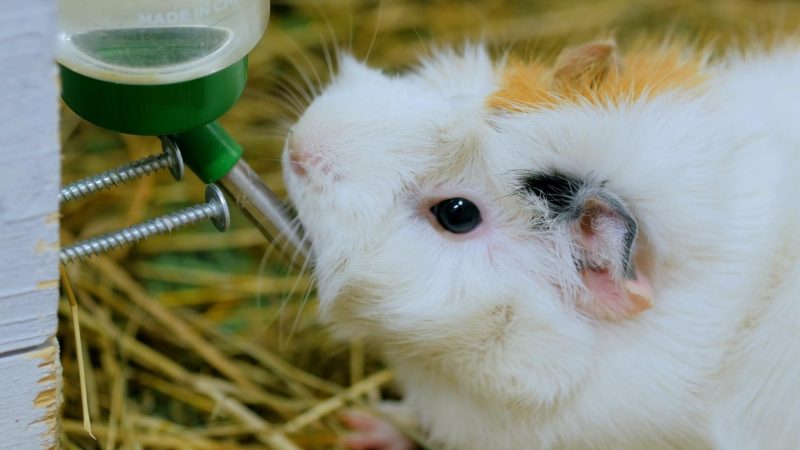This is nothing about popcorn or feeding your pet guinea pigs with popcorn. If you have those adorable little guinea pigs as pets and you are reading this, chances are you already know or have heard the term popcorning. But in case you’re not familiar with it, or you want to know more about this behavior of guinea pigs, read on.
What is guinea pigs popcorning? Popcorning is the term used for those sudden adorable leaps that your pet guinea pig does. Some guinea pig owners call the behavior “pogoing” as guinea pigs jump straight up in the air like in a pogo stick. Others even call it “pronking” or “stotting” like what springboks do as the movement is very similar (they leap in the air with arched backs and stiff legs).
You know that your pet guinea pig is popcorning when it suddenly leaps straight up from standing position or while running, or suddenly bucking like an out-of-control horse. They may run back and forth, make high-pitched squeaks before bouncing up in the air, turn the other way then do rapid hops again. It’s like a signature dance. Read on to learn more.
Table of Content
What Is Popcorning for Guinea Pigs?
Some people, when they see this kind of behavior for the first time, they think that there is something wrong with them. The action can be very sudden most of the time. It might look like your pet has a seizure or spasms. But don’t worry, it is not a sign of being hurt or of frantic behavior. This is the normal behavior of a guinea pig.
The term is coined because just like popcorn that suddenly pops or jumps in the air when heated, a guinea pig pops up like it touched a heated pan.
You, at least once in your life, felt like jumping in joy or excitement, and your pet guinea pig is no different. Guinea pigs are very social creatures, and they respond to attention and affection from their owners.
They usually popcorning as a display of happiness or excitement, or when it receives food or care from its owners. You will see this behavior more on younger guinea pigs, though it is not uncommon to see older guinea pigs popcorning too.
Guinea Pigs Caught Popcorning on the Camera
The jumps that a guinea pig does while popcorning is not particularly high though there are guinea pigs that have fantastic athleticism. Truffles, the Guinness world record holder for the longest jump of a guinea pig can jump as long as 19 inches.
For the most part, popcorning guinea pigs only jump as high as a few inches. It depends on the guinea pig, factoring age, weight, personality, and activity.
If you want to see guinea pig popcorning in action, check out this video:
Want to look at popcorning in slow motion? Check out this video:
These videos might have gotten you excited, and now you want to know how to make your guinea pigs popcorn. Unfortunately, you can’t force them to do so or train them to popcorn on your will, which is a bummer. Still, you can increase their chances of doing so if you keep them happy, fulfilled, and content.
How to See Popcorning More Often?
So, what do you need to do to make your cute little rodents happy in order to see this behavior more often? Here are some tips:
1. Give your pet guinea pig enough time to settle down.

Especially when you’ve recently adopted one, you must give it time to get used to his new home. Guinea pigs might be gentle creatures, but they are normally prey animals so their first instinct when they see a big tall creature that is standing on two legs is to run away and hide.
They need time to get to know you. It takes a bit of effort to earn their trust so be patient at first. It will go into hiding when it detects your presence. Having a good bond with your pet guinea pig doesn’t happen overnight.
2. Make sure that its home is clean and has enough room to run about.

It is important that you choose appropriate housing as a playground for your pet guinea pig. It needs to have lots of air and provide enough space. Don’t put them in closed containers like an aquarium. It might seem like a good choice, and it is pretty cheap, but it doesn’t provide good air circulation due to its solid sides.
Cages like the ones you see in pet stores might seem a popular choice too, but most of them are small. You need a large enclosure that will allow your pet to have room to run around and have enough exercise.
The recommended type of cage for guinea pigs is the ones made of cube grids and coroplast. It provides lots of room for your guinea pigs to run around and also can be easily built yourself if you don’t want to purchase from exotic pet stores. They are easy to clean too.
You can also customize the cage to your liking by including tunnels, ramps, and different levels where your pets can play a lot. Include beddings made of paper or fleece, so they have a comfortable place to rest.
The size of a guinea pig cage depends on the number of guinea pigs that you want to adopt. Here are standard sizes of guinea pig homes:
- 5 square feet – 1 guinea pig
- Between 7.5 to 10.5 square feet – 2 guinea pigs
- Between 10.5 to 13 square feet – 3 guinea pigs
- More than 13 square feet – 4 guinea pigs
Follow the recommended sizes for cages especially if you’re adopting more than one guinea pig. They tend to fight with each other for space when their playground size is small. Just make sure that the cube grids are at least 2 feet high so they won’t be able to jump out of the cage easily.
Related: What Guinea pig Cage Is The Best?
3. Give it lots of attention and interact with it often.

Like mentioned earlier, guinea pigs are very social creatures, and are not used to solitary. If you’re adopting only one guinea pig, then you need to have lots of bonding moments with it. You need to spend quality time with it more often than when you’re adopting more than one so it won’t get bored and lonely.
Remember, a lonely guinea pig will most likely not popcorn. You can do the following tips to interact with them:
- It’s recommended to adopt at least two guinea pigs so they can keep each other company when you’re not around. Still, you need to give them enough attention so they will learn to trust you. Companionship is important to them.
- The learning process for your pet guinea pigs to trust you can take anywhere from a few months to one year or so. Don’t give up or be discouraged when you think you’ve tried everything and nothing is working. Just keep on interacting with them and sooner or later you will earn their trust.
- Talking with them often and petting them will also help in increasing your bond with your rodent pets. However, make them come to you before you pet them and not the other way around so as to not scare them away. When they do come to you, try to stick your finger out and let them sniff it, then carefully pet them on their noses. But if they run away, don’t go after them and just try again later.
- Once they trust you enough and allow you to pet them, do it often but don’t always take them out of their cage just to hold them. A guinea pig will most likely panic when you take it out of its playground and get scared of you if you do it way too often.
- Just ignore them when they do any behavior that you don’t approve of and never punish them especially by hurting them. Animals don’t understand the meaning of punishment and guinea pigs are no exception.
- Reward their positive behavior with treats. The treats don’t have to be those expensive, tasty treats but just a small piece of veggies will do.
4. Make sure your pet guinea pig is well-fed and drinks plenty of water.

Guinea pigs are almost always hungry so giving them enough food will make them happy and will most likely make them popcorn. You can do the following tips for them to be well-fed:
- Hay is the staple food and an all-time favorite of guinea pigs, so make sure you have unlimited access to it. Luckily, if you have a local farm nearby, it’s pretty easy to get hay and buy it for cheap. If you can’t find a local farm nearby, then you can also purchase hay from pet stores, from vets, or online but they are more expensive.
- Look for green and soft hay with pliable stalks and avoid the ones that are yellow and hard. Also, make sure that they are pesticide-free. Timothy hay is the high-quality staple hay for rodents, but bluegrass hay, botanical hay, oat hay, orchard grass hay, and meadow hay are also good choices for your guinea pigs.
- Alfalfa and clover hays can be given as an occasional treat. They are rich in calcium which can cause build-up in the bladder and can cause urinary problems to your poor pet so don’t make it their everyday meal.
- Guinea pigs drink lots of water, so make sure you have an unlimited source of fresh, filtered (not distilled) water as well that they can drink.
- Feed them also with vegetables on the side. Some vegetables that are good for them are lettuce, cabbage, cucumber, celery, zucchini, raspberry leaves, and bell pepper. One cup of fresh vegetables daily along with their daily dose of fresh hay should be enough for a balanced diet.
- Feed them with pellets that are fortified with Vitamin C. Like humans, guinea pigs can’t produce their vitamin C, and they are very prone to scurvy if they lack this nutrient. However, pellets contain energy so going overboard might cause obesity – and overweight guinea pigs won’t likely do popcorning so regulate the number of pellets that you feed them.
- Don’t even try feeding them with popcorn.
Related: 8 Best Hay for Guinea Pigs: A Helpful Guide
How Do You Know if It Is Something More Serious and Not Popcorning?
Always check for any underlying sickness that is maybe preventing them from popcorning. An unhealthy guinea pig is not a happy guinea pig. Here are some signs that your pet might be sick:
- Sudden weight loss – It is recommended that you check your pet’s weight once a week. If you noticed that it suddenly lost weight, it is an indication that your pet guinea pig might be sick. Another way to check is by holding your pet – if you can easily feel its ribs then it is underweight, and there must be something wrong with it.
- Patchy hair loss – A guinea pig that loses fur in patches can be a symptom of something as simple as mites or something as complicated as ovarian cysts. So make sure to have it checked up as soon as possible to when you notice sudden hair loss to reveal any underlying sickness that your pet might have.
- Red and crusty eyes – If your pet has crusty eyes or it has difficulty opening its eyes, it can be a symptom of an upper respiratory tract infection or pneumonia. Take it to a vet immediately if that is the case.
- Drooling – Unless it is feeding on wet, fresh vegetables, your pet guinea pig’s mouth shouldn’t be wet. So, look for medical attention from a vet if you notice unusual drooling from your pet.
- Freezing or not moving – An obvious sign of a sick guinea pig is if it’s just lying in its cage not moving too much. Guinea pigs usually sleep from 4 to 9 hours per day in short naps of 10 minutes each. So if you notice that your pet is just lying in its cage all day and not even responding to food, it might be in pain so have it checked by a vet right away.
- Lumps – Lumps can be a sign of a tumour. Feel your guinea pig’s coat gently for any lumps that your pet might have and take it to a vet if you find any.
- Oozing or discharge from the nose – This can also be a sign of pneumonia, one of the most common causes of death in guinea pigs.
- Trouble walking or limping.
- Excretions that don’t look normal.
If there are changes in these behaviors, then have them checked by your vet. Guinea pigs can hide sickness very well though so it is a good idea to let them have regular check-ups with a vet even if they don’t look sick.
Summary
So, you followed these tips already, and you still don’t see your guinea pig popcorning? You’re not alone. Some guinea pig owners are worried when their pets don’t do popcorning at all even after providing all the needs of their pets.
Not performing this behavior doesn’t indicate that your pet is not happy with you. It hugely depends on its personality and perfectly content guinea pigs may not popcorn at all. Also, as mentioned earlier, aging guinea pigs do popcorning less and less, or stop entirely.
There are times when guinea pigs are popcorning out of fear. For the most part, popcorning is a good sign that your pet is happy and content but don’t worry if they don’t do it. Just be a happy and loving owner to your pets and take good care of them. Always provide all their needs and when they do popcorn, just enjoy the adorable display of affection from them.
